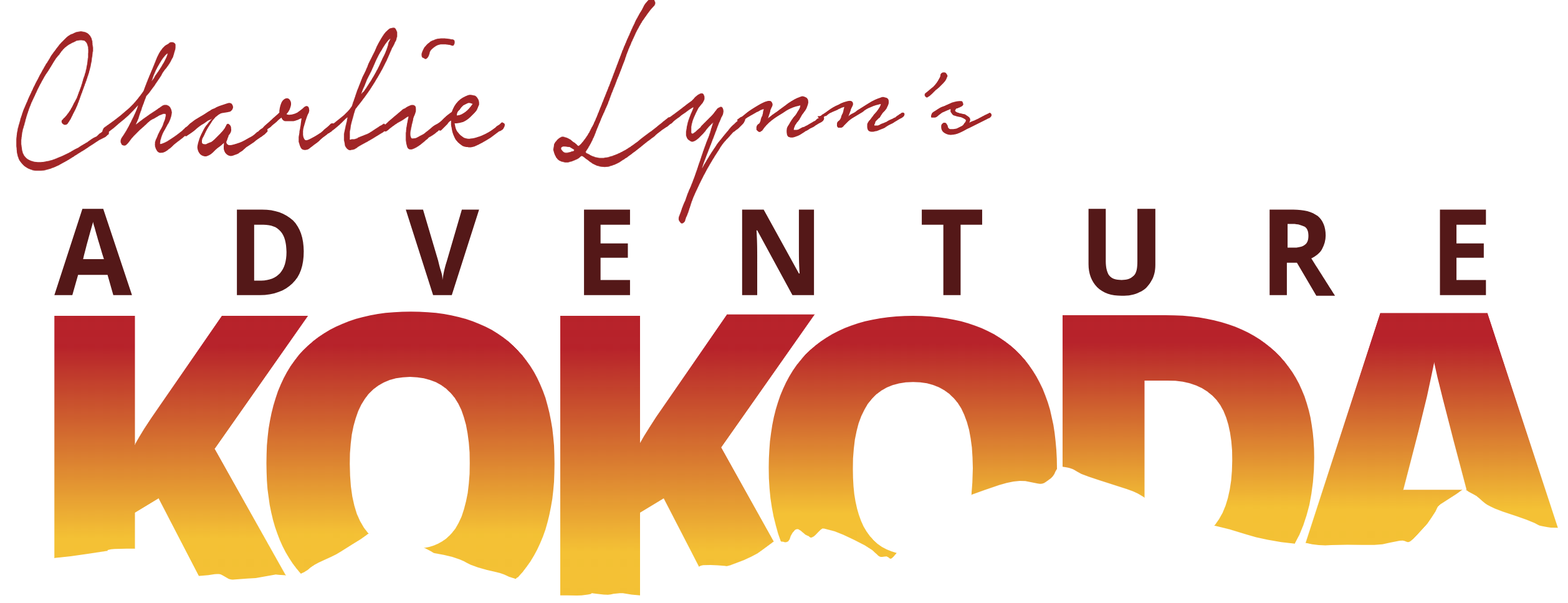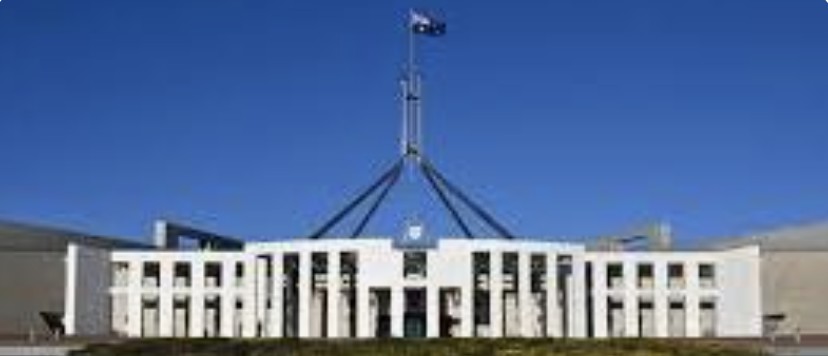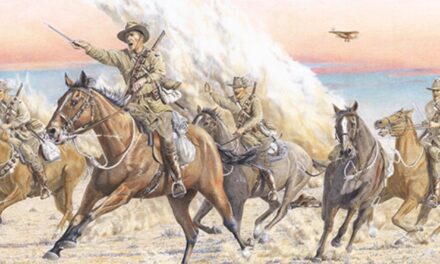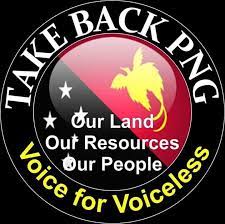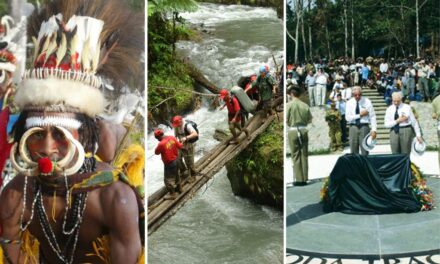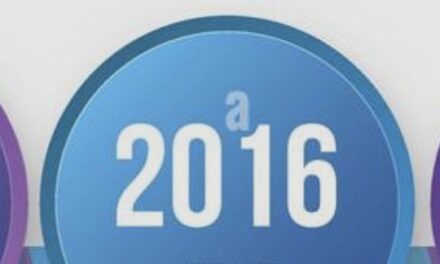Background
The Kokoda Trail lay dormant for 50 years from the time of the Kokoda campaign in 1942.
As the 50th anniversary of the campaign approached in 1991 I was invited by two Papua New Guineans, David and Bernard Choulai, to organize a race across it. The intermediaries they used were made aware that I was a former army major, an ultramarathon runner, the organizer of both the Anzac Day Marathon in Sydney and the annual Westfield Sydney to Melbourne Ultramarathon (1984-91). I was also a NSW Ultramarathon record holder in 1987.
The opportunity appealed as I was the son of an infantry veteran who has served in Milne Bay, Lae, and Finschhafen in 1943. I was born in 1945 and the stories of the war in New Guinea helped shaped my character during my formative years.
I was also influenced by my own military service which included two years in Singapore where I visited Changi prison and Kranji War Memorial many times. I later visited every Civil and Revolutionary battlefield in the United States during my two years as an exchange officer with the US Army. I was obviously impressed with the way the British and American Governments honoured their military heritage.
I expected a similar reverence to the Kokoda Trail when I began my initial research, however it was not to be. There were no topographical maps, virtually no information on the physical Trail itself, and limited information on the campaign.
After my lone trek with a local guide in 1991 I found it difficult to find words to explain the experience. I also found there was little corporate interest in sponsoring a race across it at the time as ‘Kokoda’ was not on the public radar.
The law-and-order situation in Port Moresby at the time was also a factor.
Public commentary in the early 1990s related to the Melanesian ‘arc of instability’ to our immediate north and the possibility of PNG being a ‘failed state’. The city itself was hidden behind razor-wire and a night curfew was in place. Truckloads of security personnel with dogs were brought into the city and stationed in every doorway before nightfall each day.
However, interest was aroused with the announcement that Paul Keating would become the first Prime Minister since the war to visit Kokoda.
There was a flurry of excitement within PNG tourism who hosted numerous meetings in the lead-up to the anniversary. They were expecting a large influx of visitors and wanted to make the most of it. As it turned out the numbers never eventuated, which was a blessing because there were no outcomes from any of the meetings!
In 1994 I submitted a paper calling on our Federal government to proclaim the Kokoda Trail as a National Memorial Park:
‘Any plan that is developed should consider the fact that PNG does not have a welfare system and the Koiari and Orokaiva people who live along the track operate a subsistence economy. They are also the custodians of the land on which the battles that saved Australia were fought.
‘If we develop our long term plan around providing a regular source of income for them we can be assured that they will protect and honour the battlesites we restore, the educational memorials we build and the village museums we assist with.‘The objective of the master plan should therefore be to develop a self-sustaining eco-adventure trekking industry for the Koiari and Orokaiva people who live along the Kokoda Trail.’
Channel 9 Angry Anderson Kokoda Special
In January 1996, I was invited to lead a group of television celebrities including Angry Anderson, Darryl Braithwaite, Collette Mann, Dermott Brereton and Grant Kenny across the Trail for Channel 9r After the program featured on Anzac Day it achieved the highest ratings ever recorded by ‘A Current Affair’ with almost 3 million viewers. This confirmed my view that Australians want to know more about their military history. The special can be viewed on the following link:
The success of the Channel 9 program led to increasing media interest in the Kokoda campaign and the trek:
Extracts from Ministerial Correspondance
It was also increasingly evident that despite Prime Minister Keating’s fine speeches a few months earlier, and despite my numerous requests for a Master Heritage Plan for the Kokoda Trail, the political caravan had moved as the following extracts from Ministerial correspondence attest:
4 November 1992:
‘While the proposals you have outlined in your letter of 25 August (1992) to the Prime Minister have undoubted merit, I can give no undertaking that anything of that nature would fall within the scope of the commemorative measures now under consideration’.
The Hon Ben Humphreys MP
Minister for Veterans Affairs
22 February 1995:
‘The Government’s philosophy is to commemorate and celebrate the 50th anniversary of the end of World War 11 with activities here in Australia. The only specific events relating to ‘Australia Remembers’ planned for overseas are three small pilgrimages of Australian veterans.’
The Hon Con Sciacca MP
Minister for Veterans Affairs
24 June 1997:
“As a result it is not possible to award the Civilian Service Medal to the ‘Fuzzy Wuzzy Angels’ at this distance in time.’
The Hon David Jull MP
Minister for Administrative Services
10 November 1997:
‘Your suggestion to form a small working group has merit. However, I do not recommend proceeding in this way at this time.’
The Hon Bruce Scott MP
Minister for Veterans Affairs
11 December 2000:
‘Your proposal to develop the Trail is unfortunately outside the scope of the Australian aid program.”
Senator Kay Patterson
Parliamentary Secretary to the Minister for Foreign Affairs
7 December 2000:
‘With these limitations in mind, I regret I am unable to offer any prospect of achieving the all-of-government approach you seek in the time frame you propose.’
The Hon Bruce Scott MP
Minister for Veterans Affairs
13 January 2001:
‘I believe you have presented to the Government an excellent proposal and initial plan to establish the Kokoda Track (or Trail) as a National Memorial Park – long overdue!’
Stan Bisset AM MC
President, 2/14th Battalion Association
7 February 2001:
‘Because of the above reasons and in consultation with the Chiefs of the villages along the Trail, I demanded a compensation of A$2,000,000.00 for developments along the Trail. This was not for Oro Province as a whole. However, after receiving your letter, I held discussions with the Chiefs and Councillors from the area and explained the contents of your letter in which I must say, all leaders from the area are happy with your efforts in going as far as preparing a proposal which is now before the Australian Government to develop a Master Plan for the development of the Kokoda Trail as a National Memorial Park.’
The Hon Sylvanus Siembo MP
Governor, Oro Province
18 February 2001:
‘It will come as no surprise to you then that the ‘Government Master Plan’ of which you inquire ‘for the development of the Kokoda Track as a national memorial park’ does not exist . . . I regret that I am unable to satisfy your demand for such a large scale approach to this issue.
The Hon Bruce Scott MP
Minister for Veterans Affairs
8 March 2001:
The Australian High Commission in Port Moresby welcomes Mr Lynn’s enthusiasm and commitment to develop the Kokoda Track. We acknowledge the contributions he has made in the past and note that he is highly regarded in a number of communities for his assistance. Like many Australians, he has a strong belief in the Track’s historical importance and can see its potential as a source of revenue for local people and of education and personal development for young Australians in particular. My staff and I have met with Mr Lynn on a number of occasions during his visits to Port Moresby, and we accept that he is pursuing his proposals in order to advance what he believes is in the best interests of the Kokoda Track and its people.’
H.E. Nick Warner
Australian High Commissioner to Papua New Guinea
19 March 2001:
‘Your interest and commitment to the development of the Kokoda Track reflects your strong desire to improve the living conditions of its communities. In this regard our High Commissioner to Papua New Guinea greatly values your interest and suggestions, especially with respect to small-scale projects that might fit into their preferred strategy currently being developed. I trust this letter will be useful in finally resolving the issue of why my Department will not promote the creation of a National Memorial Park.’
The Hon Bruce Scott MP
Minister for Veterans Affairs
9 May 2001:
‘I have noted your advice that the Papua New Guinea (PNG) Minister for National Planning is enthusiastic about your proposal. However, I believe the master plan you seek is a document most appropriately compiled by the Government of PNG. The Australian Department of Foreign Affairs may be interested in contributing to such a process that would provide aid and development initiatives to provinces along the Kokoda Track. But it is a matter for the Government of PNG to decide if a master plan is appropriate and what organisations might be represented on any committee brought together for the preparation of such a document. Consequently, I trust that you will understand why I will not be selecting staff from my Department to participate on your project team.’
The Hon Bruce Scott MP
Minister for Veterans Affairs
17 May 2001:
(Response to The Hon Dr Brendan Nelson MP, Parliamentary Secretary to the Minister for Defence)
‘In view of the current situation on the Kokoda Track it would be inadvisable for the Australian Government to promote a proposal for the Track’s development. The subject of Mr Lynn’s proposal is a matter, in the first instance, for the Government of PNG. It would be inappropriate for a group of Australian bureaucrats to walk the Track and develop a master plan in isolation to the situation on the ground..’
The Hon Bruce Scott MP
Minister for Veterans Affairs
17 May 2001:
‘Thank you for your e-mail of 24 April 2001 to a number of Members of Parliament, Senators and others, regarding your proposal to create a Kokoda National Memorial Park in Papua New Guinea. I have previously explained why I do not support your proposal at the present time and trust that you will refer to my earlier letters on this matter. Mr Nick Warner, Australian High Commissioner to PNG, has provided advice that your proposal is premature and inappropriate at this stage.’
The Hon Bruce Scott MP
Minister for Veterans Affairs
16 July 2001:
‘Having discussed this matter with representatives of the Papua New Guinea Government I have found no support for a park along the lines you have suggested. Other options were discussed but, in view of the social problems in the area associated with the Track, these alternatives have not been developed.’
Senator Robert Hill
Minister for the Environment and Heritage
10 August 2001:
‘As far as I am aware, the social problems associated with the track are continuing. Until such a time as these can be resolved by the people and Government of Papua New Guinea, and there is official PNG Government support for a memorial park, I am unable to consider expending resources and staff to work on a project team as you suggest.’
Senator Robert Hill
Minister for the Environment and Heritage
18 September 2001:
‘In previous correspondence, I have stated clearly that no such trek will be taking place while the security situation in the area remains uncertain and current High Commission travel advisories are in place. Further, officials and advisers on this issue have no need to embark on such a walk at public expense to capture the obvious importance of appropriate memorials being established along the Track. All members of the committee have a comprehensive understanding of the significance of the Track and what it means to the Australian community . . . the intend of the inter-departmental committee is to consider all proposals for the Track and to develop a co-ordinated response for consideration by this Government. Therefore and trek along the lines that you have proposed would be inappropriate, unnecessary and could be deemed as prejudicial to the deliberations of the committee.’
The Hon Bruce Scott MP
Minister for Veterans Affairs
28 September 2001:
‘I appreciate that there would be a great deal of planning required for such a trek but wish to reiterate that no such trek will be taking place while the security situation in the area remains uncertain and current High Commission travel advisories are in place. Further, members of the committee are already aware of the significance of the Track and the importance to the Australian community.’
The Hon Bruce Scott MP
Minister for Veterans Affairs
17 October 2001:
‘With regards to the trek, I wish to reiterate that the IDC is aware of the significance of the Kokoda Track and that as I advised previously, no such trek will be taking place while the security situation in the area remains uncertain and current High Commission travel advisories are in place.’
The Hon Bruce Scott MP
Minister for Veterans Affairs
26 October 2001:
‘The IDC currently has no plans to take part in a trek across the Track. All members of the committee have a comprehensive understanding of the significance of the Track and what it means to the Australian community.’
Dr Peter Poggioli
Chief of Staff to the Minister for Education, Training and Youth Affairs
29 October 2001:
‘Thank you for the recent information you sent regarding your proposals for the ‘big picture’ plans for the track and I wish you well. I agree that the Minister for Veterans Affairs is a hard person to deal with having spoken with a lot of the veterans and also seen the problems we have had. Good luck with getting politicians to cross the track . . . The problem I see is that without a co-ordinated approach, everyone goes off doing their little bits and it all gets confusing. A lot of people aren’t aware of the problems that occur in PNG in trying to achieve outcomes, etc. After 3 years living there, the real problems of corrupt and unintelligent government members, cronyism, wantokism, compensation and cargo cult become very apparent. Anyway Charlie, I wish you luck and if there is anything I can do to assist, please let me know.’
Ian Hopley
Australian Police Advisor in PNG
Executive Committee Member and Trustee, 2/14th Battalion Association
27 November 2001:
‘I am pleased to advise that the National Executive of the RSL has endorsed the proposal to establish a master plan for the development of the Kokoda Track Memorial Park. Thank you for taking the time to address our National Executive and for the personal effort you have put into promoting this concept.’
Major-General Peter Phillips AO MC (Retd)
National President, Returned Services League
25 January 2002:
‘Thank you for your letter of 6 December 2001 congratulating me on my recent appointment as Minister for Veterans Affairs. . . In response to you invitation to discuss your proposal for the development of the Kokoda Track as a National Memorial Park, I wish to endorse the comments of my predecessor. The inter-departmental committee (IDC) on Kokoda is currently considering all proposals for the Track and developing a co-ordinated response for consideration by this government.’
The Hon Danna Vale MP
Minister for Veterans Affairs
30 July 2002:
‘I do however wish to draw your intention to the fact that the inter-departmental committee report was established to examine Australia’s interests in Kokoda Track Development and to determine ways to enhance public recognition of its importance to Australians. Whilst the IDC included provision in the longer term for outlining a process for cooperative development, its purpose was not to develop a master plan for the future development of the Kokoda Track. . .’
The Hon Danna Vale MP
Minister for Veterans Affairs
Our Pioneering Treks
The ambivalence of the Australian Government along with the lack of any in-country logistic providers in PNG meant we were left to our own resources.
As a result, our logistics were organised from our home in Camden. All meals had to be prepacked in our kitchen. Backpacks had to be carefully prepacked and marked by the day. Our trek uniforms had to be organised and tagged. On the morning of departure, I had to hire a trailer, pack up to 50 backpacks, drive them to the airport, get them through customs, and hope that my wife, who had never driven a vehicle with a trailer attached, would be able to negotiate the peak hour traffic back home.
The flight from Sydney to Port Moresby was often the only chance I had to catch up on some sleep after a frenetic 48 hours’ preparation.
The situation was reversed after my arrival in Port Moresby. I had to explain to customs why I had so much baggage, convince them I had 25 Australians following me the next day who would contribute to the PNG economy, etc. etc. Then unpack and repack most of the gear in my room at the Gateway Hotel.
Leading the trek was the easy part of the whole operation as I had a group of PNG guides who were truly masters of their environment and who welcomed the opportunity to earn some money in an economy that seemed to be well and truly busted in the mid to late 1990s.
I hung in, despite Jill’s concern that we were in the red zone of our credit card limit, because I believed the emotional impact of the pilgrimage, the physical challenge, the authenticity of the jungle environment, and the link to traditional villagers, would appeal to dinkum Australians.
Negative media reports and ‘Traveller Alerts’ caused deep resentment amongst PNG Government officials who had their work cut-out in restoring order. Australia’s patronising attitude culminated in the frisking of PNGs much loved Grand Chief, Sir Michael Somare, by security goons at Brisbane airport. It was regarded as a national insult.
PNG was not therefore regarded as a favourable place to do business.
As the number of trekkers began to increase so did the frustrations of traditional landowners and their village communities who were receiving few financial benefits as there was no mechanism in place to identify their needs and desires.
I concluded that we needed to establish a mechanism for villagers across the Trail to receive a fair share of benefits from the emerging trekking industry. The most effective way to make this happen would be to manage the Trail as a National Park and charge a fee for trekkers. Money received from trek fees would be used to generate employment by engaging villagers to maintain the Trail and to assist in community projects.
I also believed that if traditional landowners of significant sites received a site-fee from trekkers they would protect and maintain them. During this period, I had led several mapping expeditions across the Trail and had rediscovered the original Brigade Hill and Isurava battlesites which had been bypassed and reclaimed by the jungle over the years since the war.
With this in mind I developed the concept of a philanthropic foundation to assist in the development of a sustainable eco-trekking industry based on our shared wartime heritage. My company, Adventure Kokoda, then funded the establishment of the Kokoda Track Foundation. Our logo incorporated the image of a fuzzy-wuzzy angel assisting a wounded digger.
My position as an elected Member of the NSW Parliament allowed me to organise some large fundraising functions based on an annual ‘Ralph Honner Oration’ at Parliament House. These were well patronised, and we raised significant funds for the Foundation.
I invited a small number of Sydney based trekkers to join me on the Board of Directors which I chaired.
I had also discussed the opportunity for a group of AFL footballers from the Sydney Swans to trek Kokoda with the CEO, Kelvin Templeton, a former Brownlow Medallist. During our discussions I learned that Kelvin had a strong intellectual interest in indigenous affairs.
We then discussed the opportunity to run a series of workshops with key stakeholders along the Kokoda Trail and within the trekking industry, in Australia and PNG.
We agreed that I would raise the funds necessary to support the workshops and he would enlist the support of Dr Stephen Wearing from the University of Technology in Sydney. Dr Wearing is a leading academic in the field of sustainable eco-development in Third World countries. He then enlisted the support of Paul Chatterton from the World Wide Fund for Nature (WWF) in PNG. Paul was a long-term advocate for the protection of pristine rainforest and endangered species in PNG. He was also fluent in Tok-Pisin.
I was able to raise approximately $200,000 to cover the cost of workshops in Sydney, Port Moresby, Efogi village and Kokoda. It was hard yakka as the Board I established to assist with raising funds were more adept at giving advice than generating dollars!
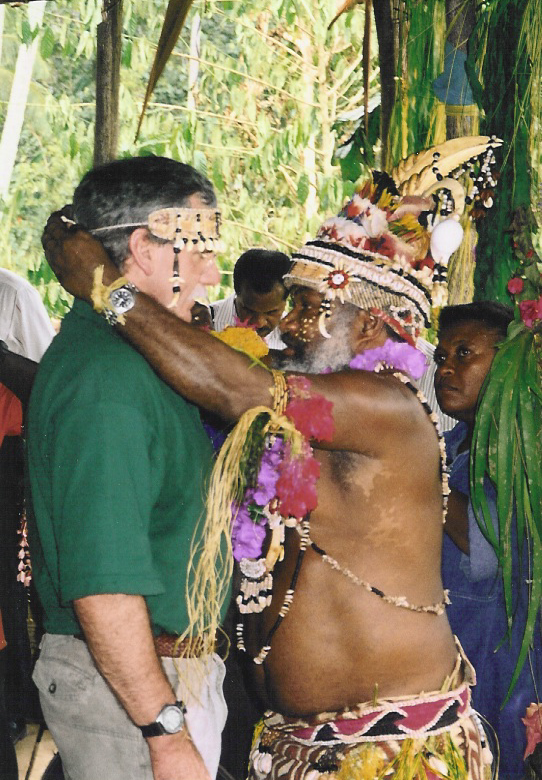
The outcome of our first village-based workshops can be viewed on this link:
Governor Sylvanus Siembo, who had previously ordered the closure of the Trail over his frustrations at the lack of village benefits from the emerging industry, made a short speech and presented me with a traditional headband:
‘This headband that I have put around your head is a symbol of a chief and is sacred. It is only worn by chiefs in the Oro Province.
‘This headband you wear marks you as one of the chiefs of the Orokaiva people because of your hard work to my people in our endeavours to reaching a lasting solution to the famous Kokoda Trail closure. This headband and necklace that I presented to you today marks our brotherly relationship and a lasting memory to live on in future generations to come.’
I eventually had the opportunity to present our strategic plan to Prime Minister Sir Michael Somare at a private function in 2006. I also submitted it to the Minister for Veterans Affairs but did not receive a response. We maintained detailed records of all workshops conducted in Sydney, Port Moresby, Efogi village, and Kokoda. These can be viewed on this link:
Unfortunately my emphasis on our shared military heritage and the commitments I made to local communities along the Trail during my treks created tensions within the non-military members of our Board as they had little appreciation of the reality of the ‘Melanesian Way’.
I was consistently advised of the need to have local communities relay requests for support to the Board for consideration as part of our approval process. They were unaware of the difficulty of explaining this approach when I was surrounded by hostile villagers waving machetes and spitting betel nut as part of their normal ‘negotiating process’. They invariably wanted some form of commitment before they would allow our groups to continue. At that stage I was involved with politics on a daily basis in the NSW Parliament and didn’t have the appetite to be involved in the politics of the Board I had created.
I therefore resigned from the Foundation and asked that my name be removed from their records as it was becoming increasingly clear they would prefer to be a quasi-aid agency further afield in PNG than a protector of our shared military heritage across the Trail.
This was confirmed by Dr Nelson in her interview with Dr Bino:
‘The formation of the Kokoda Track Foundation (KTF) could be viewed as an effort to achieve these goals, and so could the subsequent decision to remove the Australian based trek operators from its board of management, since this would remove any perception of bias in the way that it managed the donations (interview, Dr Genevieve Nelson 2011)’.
Dr Nelson had neglected to advise Dr Bono that I had developed and funded the concept of the philanthropic body; that I had introduced her to the Trail; led the two treks she participated in; funded her first visit to PNG as a PhD student; and introduced her to many valuable contacts.
The Foundation then distanced themselves from our military heritage by changing their name to ‘KTF’ and replacing the ‘fuzzy-wuzzy angel’ logo with a blue butterfly. They now operate as largely and aid-funded NGO in search of a cause beyond the Kokoda Trail in PNG.
Discovery of Isurava Battlesite
In 1996 I rediscovered the original Isurava battlesite on a mapping expedition I had led.
I advised Senator Bill Heffernan who arranged for Prime Minister John Howard to provide a Boeing 707 to fly veterans to the site for a ‘last parade’.
The Howard Government then commissioned a heritage architect to develop a commemorative memorial for the site which was officially opened by Prime Minister John Howard and the PNG Prime Minister, Sir Michael Somare on the 60th anniversary of the battle in 2002.
It was indeed a proud day for the surviving veterans who attended the ceremony. The late Phil Rhoden, commander of the 2/14th Battalion at the Battle for Isurava wrote:
“The veterans and I, in particular, are aware of your work over many years in you bringing the events in 1942 to the attention of all who would listen to you and some who would not and were it not for that persistence and endeavour of yours the words ‘courage, endurance, mateship and sacrifice’ would not be at Isurava for all to see.”
On 15 November 2002, I was invited to a private meeting with the Prime Minister of PNG, Sir Michael Somare at the Sheraton on the Park Hotel in Sydney by the PNG High Commissioner, H.E. Renagi Lohia. I was asked if I could arrange a meeting between Sir Michael and the NSW Premier, Bob Carr. I was able to do this and the following day I escorted the Prime Minister to the Premier’s office and introduced them. I believe this was the start of a close relationship between them.
I received the following note from the Premier after I wrote to thank him for hosting the meeting at such short notice:
“I’ve always been impressed by your love of the Track and your determination to ensure its place in the Australian imagination is never lost.
“You know better than most that the Kokoda Track isn’t just a place where our salvation was won – though we should remember and document and treasure every inch of it. Kokoda’s now part of the Australian Dreaming, a sacred site.
“More than that the Men of Kokoda are among the greatest of heroes in a land that rightly canonizes few heroes. And as time slowly steals the survivors from our midst, it’s hard to resist thinking that Australians in the not too distant future will look back with almost disbelief at the giants who lived in those days.”
The continued lack of any sort of management system allowed the ‘law of the jungle’ to prevail while landowners became more frustrated as their interests were ignored.
Australian High Commissioners in Port Moresby, Nick Warner, and his successor, Michael Potts were aware of the situation but unable to implement any sort of management system without the consent of the PNG Government.
I then approached Sir Peter Barter, the PNG Minister for Provincial and Local Government Affairs and Intergovernmental Relations, to seek his support in establishing a management body. This was new ground for PNG as there was no precedent for operating such a place as a National Park. Sir Peter therefore established a ‘Kokoda Track (Special Purpose) Authority’ which became known as the KTA.
Unfortunately, he was not able to provide any funds to support the new body and there was no interest in the enterprise from the Australian Government.
My company, Adventure Kokoda, provided an advance of $10,000 to engage a CEO and establish an office facility. Mr Warren Bartlett, a former Kiap who was providing our logistic support in PNG, was engaged on an annual salary of $12,500, and provided with a part-time assistant.
A Board of Directors was duly appointed however they had no qualifications or experience in commerce, governance, tourism, or trekking. This would soon lead to serious challenges for the CEO who had to seek to protect the finances of the KTA.
A trek fee of K200 was introduced but was bitterly opposed by many of the trek groups which added to the initial stresses Bartlett had in his endeavours to bring a degree of order to the trekking industry.
Sir Peter later wrote:
“Without Charlie Lynn’s dedication to the people of the Kokoda Trail, and Papua New Guinea in general, and his assistance in early negotiations in the establishment of the Authority, the establishment of the Kokoda Track Authority and its future plans for assisting the sustainability of the Kokoda Track Tourism Strategy and its heritage, there would be no special purposes authority – it would still be sitting in limbo.”
The Kodu Goldmine adjacent to the Kokoda Trail
The next major issue we had to confront was the appearance of survey pegs on the southern slopes of the Maguli Range and the clanking of bulldozers as they prepared to open a rich gold and copper deposit nearby on the adjacent range.
I was able to use my political and media contacts to voice our serious concerns over the possible intrusion of mining operations on the Trail itself.
The Howard Government reacted by offering assistance to the PNG Government to stop the mine and protect the Trail from any future incursions from forestry or mining operations. It was decided that the most effective strategy would be to seek a World Heritage Listing for the Trail and the surrounding Owen Stanley Ranges.
By this time trekker numbers had increased from 1584 in 2004 to 5621 in 2008.
This placed an impossible strain on the CEO, Warren Bartlett, as he sought to keep an increasingly corrupt Board of Directors in check and manage an increasing number of rogue trek operators who were ignoring the need to pay for trek permits. According to an audit he arranged at a checkpoint half-way along the Trail in 2008 rogue trek operators had failed to apply for 1600 trek permits which resulted in a serious reduction in income.
Canberra’s ‘Kokoda Initiative’
The Australian Department of Environment, Water, Heritage, and Arts (DEWHA) was allocated responsibility for the Kokoda Trail as it was responsible for the heritage of ‘overseas places of interest to Australia’. A ‘Joint’ Understanding (developed and funded by Canberra) was signed with the PNG Government in March 2008.
The management system on the Trail at this stage was non-existent. Trek operators were desperate for some order to the system however there was no sign of any urgency from the advance DEWHA team to address this issue.
When Warren Bartlett met with one of the DEWHA officials, Troy Irwin, to express our concerns he was advised that ‘it won’t make any difference if they have to wait another year!’ Irwin was an office based government official on a secure aid-funded salary. He had made no attempt to consult with professional trek operators to gain an insight into the reality of the Kokoda pilgrimage
Irwin was followed by an influx of environment officials who had no previous experience with PNG, Melanesian culture, military history, pilgrimage tourism, or commercial enterprise.
There was much confusion at the time as a Kokoda Development Program was being run by the Australian High Commission and a new DFAT funded ‘Kokoda Initiative’ was assigned to the PNG Conservation Environment Protection Authority (CEPA). They were merged many years later but in the intervening period there was a considerable amount of confusion as to their respective roles.
The Kokoda Initiative and Kokoda Development programs were eventually amalgamated, and Australian environment officials were embedded in the Conservation Environment Protection Authority CEPA).
They assumed control of the KTA via the establishment of a Kokoda Initiative Ministerial Committee (KIC) and technical Working group (TWG) Their influence over the allocation of aid funded projects across the Trail provided them with ‘big-man’ status in this domain despite allegations of financial impropriety within CEPA.
Under DEWHA management the KTA enjoyed a 10-fold increase in staff and a multi-million dollar budget via the DFAT Kokoda Initiative to manage Kokoda tourism. But rather than getting out onto the Trail with professional trek operators to gain an understanding of trekkers aspirations and the needs of guides, carriers, campsite owners and villagers they chose to lock themselves within their Port Moresby office and conduct meetings and forums to ‘build capacity’, develop ‘mentoring programs’, look at ‘gender equity’ issues, and follow the dictates of Canberra regarding ill-conceived ‘village livelihoods’ type projects.
The needs of the pioneering trek operators for management protocols such as a credible licensing system, a campsite booking system, a trek itinerary managements system, a campsite development plan, a trail maintenance program, and a military heritage plan were ignored.
The ‘law of the jungle‘ continued to prevail which resulted in bitter disputes along the Trail as different trek groups with a combined total of up to 50-60 trekkers would arrive at a campsite with a capacity for 15-20! Some rogue trek groups did not supply enough meals for the trekkers. Others did not have any trained medical staff or communications equipment which resulted in a couple of preventable deaths. These experiences led to negative publicity and a serious decline in trekker numbers under the new Kokoda Initiative-KTA regime.
After the election of the Rudd Labor Government DEWHA ‘Heritage’ was removed from the title and it was rebadged as the Department of Sustainability, Environment, Water, Population and Communities (DSEWPC).
Soon after, Prime Minister Rudd appointed Mr Sandy Hollway as his ‘special envoy to Kokoda’ to address increasing tensions across the Trail as a result of the ongoing management dysfunction.
Hollway was a highly respected official however he knew little about PNG or the complexities and subtleties of the ‘Melanesian Way’.
I arranged a meeting to introduce Colonel David Knaggs with a recommendation that he be engaged as part of his team to assist in facilitating meetings and workshops with PNG stakeholders.
Knaggs had served with the PNGDF for two years during his army career, is fluent in Tok Pisin, has a good empathy with PNG culture, and had trekked Kokoda. He was a former Director of Communications and Information Systems for the Australian Defence Force and worked as a consultant for Templeton-Galt where he was engaged to facilitate workshops in Port Moresby, Kokoda and Sydney for the Kokoda Track Foundation in the lead-up to the development of their strategic plan for the Kokoda Trail.
I also recommended that Sandy Lawson be engaged as part of the team. Sandy had worked in PNG as an agricultural scientist for more than 40 years, was fluent in Tok-Pisin, Motu, and Koiari and Orokaiva ‘Ples Tok’. He was highly respected by traditional landowners across the Trail as he had worked with them for a couple of decades.
Neither Knaggs nor Lawson were contacted, and it was soon evident that Hollway had been engaged to provide a political fix for the Australian media rather than a management solution for PNG.
Apart from the conduct of a few forums and the official opening of an aid-funded health centre in Efogi village there were no identifiable outcomes from the forums he conducted.
We were then advised of a Kokoda Initiative plan to engage a ‘Chief Ranger’ to bring some order along the Trail.
We recommended that one of our trek leaders, Captain Reg Yates, be recruited,
Yates was well qualified for the position. He is Australia’s foremost expert in WW11 battlefields in PNG and has documented them all over a 35-year period. He authored the Australian Army Guide for Adventure Training in PNG. He is fluent in Tok Pisin and has been trekking Kokoda for more than 35 years. He is well respected by elders along the Trail and is also a highly trained paramedic and former Ambulance officer. I suggested he could train and qualify local village rangers in advanced remote area First Aid, assist with training health officers in medical clinics, prepare a detailed trail maintenance plan, conduct an audit of health centres across the Trail, and train local rangers in areas their traditional areas of responsibility.
He was never given the curtesy of an interview and the local Ranger system has never been fit for purpose across the Kokoda Trail..
The Kokoda Initiative has since elected to engage Queensland Parks to engage a Ranger on six-figure salary packages to train PNG rangers for the Trail. The Queensland ranger has no previous experience in PNG, no language skills, no knowledge of the complexities of local clan relationships across the Trail, and no association with the reality of the Kokoda trekking industry!
On reflection is seems the Kokoda Initiative had an unwritten policy of not engaging former military or Australian expats even though their previous experience in PNG, their qualifications, language skills, and empathy with PNG culture equips them well to give informed advice. In 2012 the Australian management contingent transferred responsibility for managing Kokoda tourism to their PNG counterparts without having recruited any skilled personnel with management qualifications or providing them with any management protocol to run the operation. They left them with a ‘Kokoda Track Strategic Plan: 2012-2015’ but the evidence reveals that not a single one of the five key strategies or 33 objectives was achieved during that period. Their plan been quietly shelved since then and no questions have ever been asked.
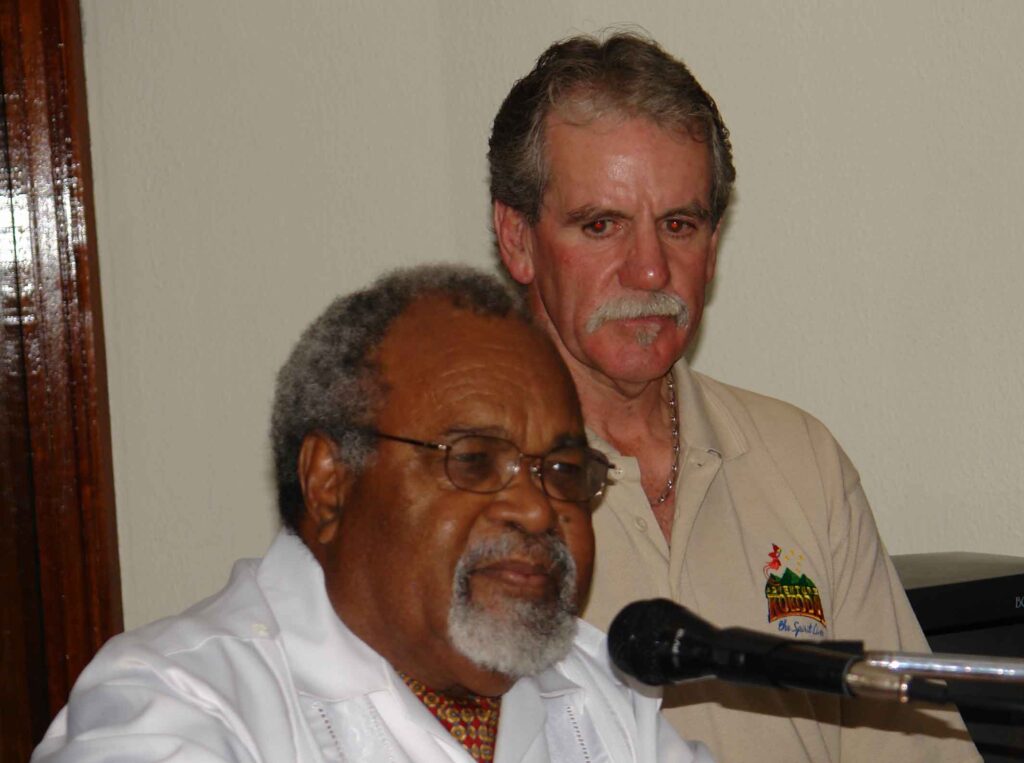
Prime Minister Sir Michael Somare accepting the Strategic Plan developed by the Kokoda Track Foundation at the Airways Hotel on 25 April 2006
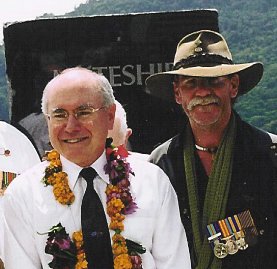
Prime Minister John Howard with Charlie Lynn at the official opening of the Isurava Memorial on the 60th Anniversary of the Kokoda Campaign in 2002
